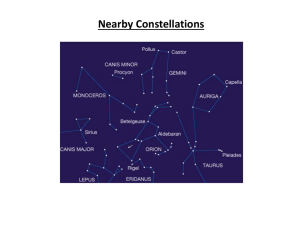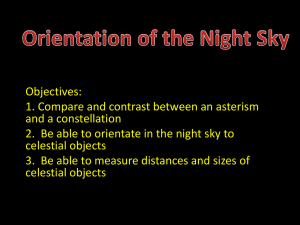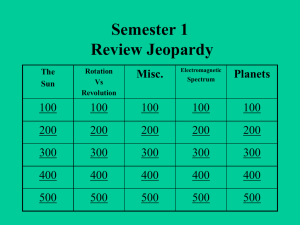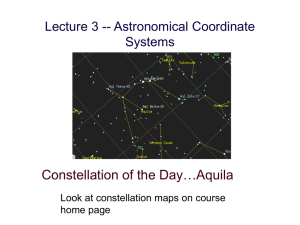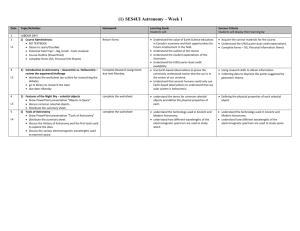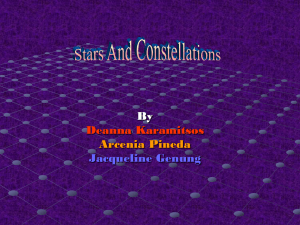Astronomy Unit 1 – Unit Overview
advertisement
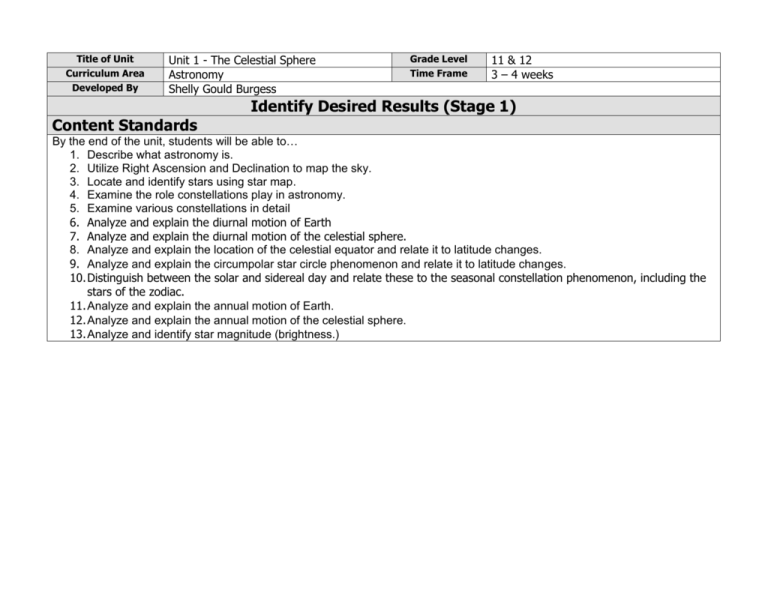
Title of Unit Curriculum Area Developed By Unit 1 - The Celestial Sphere Astronomy Shelly Gould Burgess Grade Level Time Frame 11 & 12 3 – 4 weeks Identify Desired Results (Stage 1) Content Standards By the end of the unit, students will be able to… 1. Describe what astronomy is. 2. Utilize Right Ascension and Declination to map the sky. 3. Locate and identify stars using star map. 4. Examine the role constellations play in astronomy. 5. Examine various constellations in detail 6. Analyze and explain the diurnal motion of Earth 7. Analyze and explain the diurnal motion of the celestial sphere. 8. Analyze and explain the location of the celestial equator and relate it to latitude changes. 9. Analyze and explain the circumpolar star circle phenomenon and relate it to latitude changes. 10. Distinguish between the solar and sidereal day and relate these to the seasonal constellation phenomenon, including the stars of the zodiac. 11. Analyze and explain the annual motion of Earth. 12. Analyze and explain the annual motion of the celestial sphere. 13. Analyze and identify star magnitude (brightness.) Understandings Essential Questions Overarching Understanding Students will understand how and why the celestial sphere appears to move as it does when viewed from Earth’s northern hemisphere. Overarching What is astronomy? How do we map the celestial sphere? Topical Related Misconceptions Many common misconceptions about celestial motion will be cleared up as a result of mastering this unit. What are constellations? What is the diurnal motion of Earth and the celestial sphere when viewed from Earth? What is the annual motion of Earth and the celestial sphere when viewed from Earth? How do we measure star magnitude? Why do people study astronomy? What is a zenith? What is Right Ascension? o How is RA measured? What is Declination? o How is DEC measured? What is the celestial equator? How does the celestial equator change with latitude? How do we use RA and DEC to locate and identify stars? What role do constellations play in astronomy? What are some constellations in our sky? How does Earth move diurnally? How and why does the celestial sphere appear to move diurnally when viewed from Earth’s northern hemisphere? What is a solar day? What is a sidereal day? Why does the phenomenon of the seasonal constellation occur? (Relate to solar day/sidereal day discrepancy.) What is the zodiac? What is PN? What are circumpolar stars? How do PN, circumpolar stars, and seasonal constellations change with latitude? How does the star magnitude scale work? Knowledge Skills Students will know… Students will be able to… What astronomy is. Use RA/DEC and a star map to identify and locate stars on the What a zenith is. planetarium dome. Locate the celestial equator at various latitudes. What the celestial sphere is. Predict which constellations will be seasonal at various latitudes. What RA and DEC are and how they’re measured. Locate the PN at various latitudes. What the celestial equator is. Identify the range of the circumpolar star circle at various latitudes. What role constellations play in astronomy. Predict which constellations will be circumpolar at various latitudes. How Earth moves diurnally. Identify the magnitude of a star given a measurement tool. How the celestial sphere appears to move diurnally when viewed from Given the magnitudes of a pair of stars, determine which star is Earth. The difference between a sidereal and solar day and how that creates the brighter. seasonal constellation phenomenon (example: the zodiac.) What PN is. What the circumpolar star circle is. What star magnitude is. From: Wiggins, Grant and J. Mc Tighe. (1998). Understanding by Design, Association for Supervision and Curriculum Development ISBN # 0-87120-313-8 (ppk) Lesson 1 I. Objectives: Students will be able to… Describe what astronomy is. Utilize Right Ascension and Declination to map the sky. Locate and identify stars using star map. II. Materials: Classroom set of computers with ActivStudio; planetarium III. Procedure: A. What is astronomy? 1. Flipchart page 1: Open discussion 2. Flipchart page 2: Notes B. Notes: Pages 3 – 6 using the ABC Groups strategy to break material into “digestible bites”: At strategic points, students in triads must each add something they just learned to a dry erase board. Each person (A, B, and C) must list something different. Then they must identify anything they’re confused on. Finally, they must predict what they think will come next. C. Planetarium lab on page 6: Students in teams must find the coordinates of two stars and locate them on the dome. IV. Evaluation: performance on planetarium lab, quiz Lesson 2 I. Objectives: Students will be able to… Examine the role constellations play in astronomy. Examine various constellations in detail II. Materials: Classroom set of computers with ActivStudio; planetarium III. Procedure: A. Notes and discussion: page 7 B. Activity: Constellation Detective C. Cooperative Learning: Constellation Jigsaw (p. 8) IV. Evaluation: Performance on activity and jigsaw activity, quiz Lesson 3 I. Objectives: Students will be able to… Analyze and explain the diurnal motion of Earth Analyze and explain the diurnal motion of the celestial sphere. Analyze and explain the location of the celestial equator and relate it to latitude changes. II. Materials: Classroom set of computers with ActivStudio; planetarium III. Procedure: A. Notes: pages 9-10 (Must be done in planetarium) B. Activity: While progressing through pages11-14, do meridian diagrams using Meridian Diagram Blanks and the Pair-Check strategy: Partner A works on the first problem or question while Partner B coaches and praises Partner A’s work when complete. The partners switch roles and Partner B now works on the next question while Partner A coaches. The pair then checks their answers to both problems with the other pair in their group. IV. Evaluation: Performance on activity, quiz Lesson 4 I. Objectives: Students will be able to… Analyze and explain the circumpolar star circle phenomenon and relate it to latitude changes. II. Materials: Classroom set of computers with ActivStudio; planetarium III. Procedure: A. Notes: page 15-18 using Pair-Check on Meridian Diagram Blanks B. ABC Groups break after page 18 C. Continue Pair Check strategy through more practice diagrams up to page 22 D. Stellarium lab IV. Evaluation: Performance on activities, quiz Lesson 5 I. Objectives: Students will be able to… Distinguish between the solar and sidereal day and relate these to the seasonal constellation phenomenon, including the stars of the zodiac. II. Materials: Classroom set of computers with ActivStudio; planetarium III. Procedure: A. Notes: pages 23-29 with ABC group breaks at strategic points B. Activity: In groups of four, two team members coach two other team members acting as the Sun and Earth to model sidereal and solar days. IV. Evaluation: Performance on activities, quiz Lesson 6 I. Objectives: Students will be able to… Analyze and identify star magnitude (brightness.) II. Materials: Classroom set of computers with ActivStudio; planetarium III. Procedure: A. Concept attainment activity: page 30 B. Notes: page 31 C. In the planetarium: View some of the stars from the concept attainment activity. IV. Evaluation: Performance on group activity, quiz Cumulative Project: Unit 1 Outdoor Astronomy Lab Culminating Project: Celestial Travel Agency Unit Reading Assignment: Scanned reading document on student shared drive Unit 1 Homework

